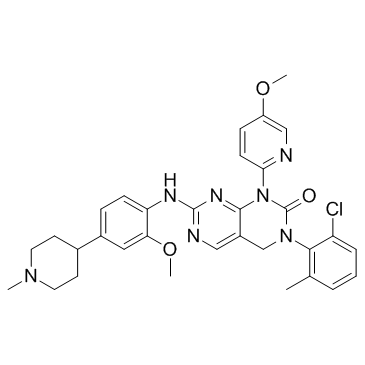| Description |
YKL-05-099 is a salt-inducible kinase (SIK) probe; inhibits SIK2 with an IC50 of 40 nM.
|
| Related Catalog |
|
| Target |
IC50: 40 nM (SIK2)[1]
|
| In Vitro |
YKL-05-099 has slightly less potent SIK2-inhibitory (IC50=40 nM) and IL-10-enhancing activities (EC50=460 nM). YKL-05-099 binds to SIK1 and SIK3 with IC50s of 10 and 30 nM, respectively, in a competitive binding assay. Preincubating bone marrow-derived macrophages with YKL-05-099 reduces LPS stimulated phosphorylation of HDAC5 at the SIK-specific phosphorylation site Ser259. YKL-05-099 suppresses production of the inflammatory cytokines TNFα, IL-6 and IL-12p40, and only modestly enhances IL-1β release in BMDCs stimulated with the yeast cell wall extract Zymosan A[1].
|
| In Vivo |
YKL-05-099 is non-toxic at concentrations less than 10 μM and stable in mouse liver microsomes for more than 2 hours. YKL-05-099 is highly soluble (PBS solubility=428 μM) and present in an unbound state at appreciable levels in mouse plasma. YKL-05-099 dose dependently decreases phosphorylation of HDAC5 at the SIK-regulated site Ser259; reduced phosphorylation is observed at the lowest dose (5 mg/Kg) and is below the limit of detection by immunoblotting beginning at the 20 mg/Kg dose. YKL-05-099 dose-dependently reduces abundance of TNFα in serum beginning at 5 mg/Kg, and increases IL-10 levels at the 20 mg/Kg dose by more than 2-fold[1].
|
| Animal Admin |
Mice: YKL-05-099 is diluted in 5% N-methyl-2-pyrrolidinone, 5% Solutol HS15 and 90% normal saline and administered IP to male 8–10 week-old C57BL/6 mice. Serum and tissue samples are collected after euthanizing mice by CO2 inhalation overdose followed by cervical dislocation[1].
|
| References |
[1]. Sundberg TB, et al. Development of Chemical Probes for Investigation of Salt-Inducible Kinase Function in Vivo. ACS Chem Biol. 2016 Aug 19;11(8):2105-11.
|
